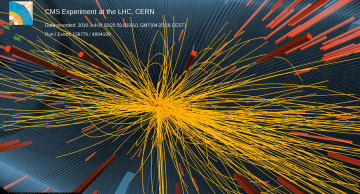The CMS Collaboration at CERN released today a paper entitled "Observation of Long-Range Near-Side Angular Correlations in Proton-Proton Collisions" that details signs of a new phenomenon in proton interactions.
A study of "high multiplicity"…
For the past four months the LHC has been ramping-up the intensity of the beams, creating billions of 7 TeV proton-proton collisions. This has enabled CMS to study a variety of known physics from the Standard Model, including the "re-discovery" of…
The first 7 TeV (3.5 TeV + 3.5 TeV) collisions took place on 30th March 2010, starting around 1pm local (Geneva) time and lasting for about 3.5 hours. Read the CERN Press Release here.
The CMS detector and its collaborators are all eagerly awaiting…
After the success of the LHC restart in late 2009, the machine had its first Technical Shutdown over the Christmas period, lasting until the end of February. This time was used fruitfully, both by the accelerator and by CMS (see the first CMS Times…
On 14th December, just 3 weeks after its restart, the LHC collided 1.18TeV beams of protons in CMS for the first time. During this first period more than 15000 2.36 TeV collision events were accumulated by CMS.
You can keep up with the excitement…
On 23rd November the LHC collided 450 GeV beams of protons for the first time (see here) but only for a short period as a trial. The first real period of collisions started on 6th December. The aim for the coming days is to accumulate about 100000…
Following the "splash" events of 6th/7th November (see here) the time has come to circulate the proton beams all around the LHC. This started in the early evening (Geneva time) on friday 20th and by midnight the beam had been circulated in both…
On the weekend of 6th & 7th November the LHC beam was injected and arrived near the CMS experiment, before being "stopped" by a large amount of material known as a "collimator". The interaction of the protons with the dense material produced "…
Pagination
- Previous page
- Page 1
- Current page 2
- Next page

